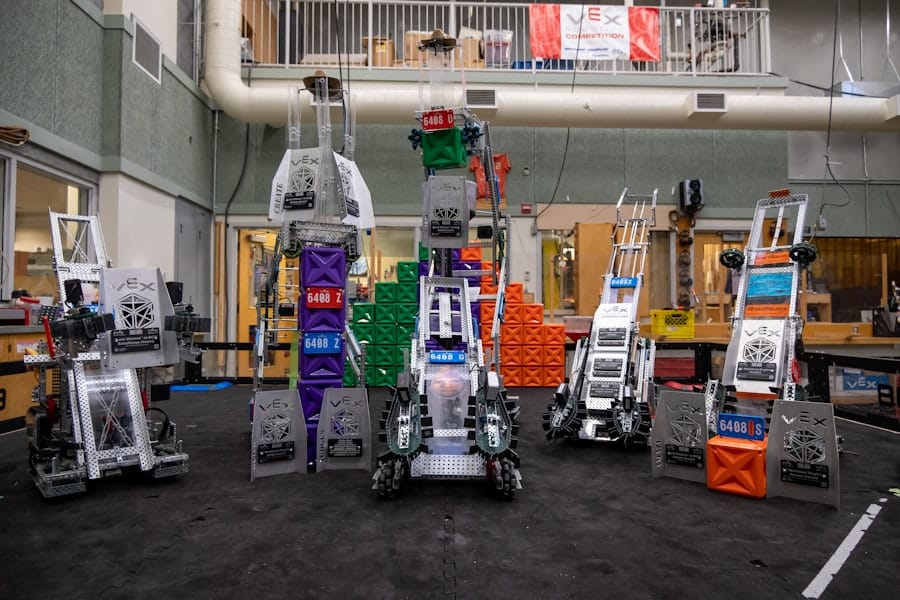The concept of household robots has transitioned from the realm of science fiction into a tangible reality, reshaping the way we manage our daily lives. These machines, designed to assist with various tasks around the home, have gained significant traction in recent years, driven by advancements in artificial intelligence, machine learning, and robotics. The idea of having a mechanical assistant that can perform chores, provide companionship, or even enhance security is no longer a distant dream but an emerging facet of modern living.
As technology continues to evolve, the integration of robots into our homes is becoming increasingly sophisticated, leading to a redefinition of domestic life. Household robots encompass a wide range of devices, from simple vacuum cleaners to complex systems capable of interacting with family members. The appeal of these robots lies not only in their ability to alleviate mundane tasks but also in their potential to enhance the quality of life for individuals and families.
As we delve deeper into the current uses and future possibilities of household robots, it becomes evident that they are not merely tools but companions that can enrich our daily experiences.
Key Takeaways
- Household robots are becoming increasingly common and are designed to assist with various tasks in the home.
- Current uses of household robots include cleaning, security, entertainment, and companionship.
- Advancements in household robot technology include improved AI, voice recognition, and mobility, making them more capable and user-friendly.
- Potential future applications of household robots may include healthcare assistance, childcare, and personalized home management.
- Household robots have the potential to significantly impact daily life by saving time, increasing convenience, and improving quality of life.
Current Uses of Household Robots
Today, household robots are primarily utilized for tasks that are repetitive or labor-intensive, allowing humans to focus on more complex and fulfilling activities. One of the most prevalent examples is the robotic vacuum cleaner, such as the Roomba, which autonomously navigates through homes to clean floors. These devices utilize sensors and mapping technology to efficiently cover spaces, avoiding obstacles and adapting to different floor types.
The convenience they offer has made them a staple in many households, significantly reducing the time and effort required for routine cleaning. In addition to vacuuming, household robots have expanded into other areas such as lawn care, window cleaning, and even cooking. Robotic lawn mowers, for instance, operate similarly to their indoor counterparts by autonomously cutting grass while avoiding obstacles.
Meanwhile, kitchen robots like the Thermomix combine multiple cooking functions into one device, allowing users to prepare meals with minimal effort. These innovations not only save time but also encourage individuals to engage more with their culinary skills without the burden of extensive preparation and cleanup.
Advancements in Household Robot Technology

The rapid advancement of technology has propelled household robots into a new era of functionality and intelligence. One significant development is the integration of artificial intelligence (AI) and machine learning algorithms that enable robots to learn from their environment and improve their performance over time. For example, modern robotic vacuums can create detailed maps of a home’s layout, allowing them to optimize cleaning routes and remember specific areas that require more attention.
This level of adaptability was unimaginable just a few years ago and marks a significant leap in robotic capabilities. Moreover, advancements in voice recognition and natural language processing have allowed household robots to interact more seamlessly with users. Devices like Amazon Echo and Google Home serve as hubs for smart home technology, enabling users to control various appliances through voice commands.
This integration fosters a more intuitive user experience, as individuals can communicate with their robots in a natural manner rather than relying on complex programming or remote controls.
Potential Future Applications of Household Robots
Looking ahead, the potential applications for household robots are vast and varied. One promising area is the development of social robots designed to provide companionship and emotional support. These robots could be particularly beneficial for elderly individuals or those living alone, offering not only practical assistance but also social interaction that can combat feelings of loneliness.
For instance, robots like ElliQ are already being tested as companions for seniors, engaging them in conversation and encouraging them to participate in activities that promote mental well-being. Another exciting frontier is the integration of household robots with smart home ecosystems. As homes become increasingly connected through the Internet of Things (IoT), robots could play a central role in managing these systems.
Imagine a robot that not only cleans your home but also monitors energy usage, adjusts lighting based on your preferences, and even alerts you to potential security threats. This level of integration could lead to more efficient energy consumption and enhanced safety measures within households.
Impact on Daily Life
The impact of household robots on daily life is profound, particularly in terms of time management and lifestyle enhancement. By automating routine tasks such as cleaning and cooking, these devices free up valuable time for individuals and families to engage in activities they enjoy or prioritize personal development. For instance, parents can spend more quality time with their children instead of being burdened by household chores, fostering stronger family bonds and enriching their relationships.
Furthermore, the presence of household robots can lead to improved mental health outcomes. The reduction of stress associated with maintaining a clean and organized home can contribute positively to overall well-being. Additionally, for individuals with disabilities or mobility challenges, household robots can provide essential support that enhances independence and quality of life.
The ability to manage one’s environment with the assistance of technology can empower users and promote a sense of agency that might otherwise be difficult to achieve.
Ethical and Social Implications of Household Robots

As household robots become more integrated into our lives, ethical considerations surrounding their use must be addressed. One major concern is privacy; many household robots are equipped with cameras and microphones that could potentially infringe on personal privacy if not properly managed. The data collected by these devices raises questions about who has access to this information and how it is used.
Ensuring robust data protection measures will be crucial as these technologies become more prevalent. Additionally, there are social implications related to employment and labor dynamics. As household robots take over tasks traditionally performed by humans, there is a risk of job displacement in certain sectors.
While these devices can enhance efficiency and reduce costs for consumers, they may also contribute to economic disparities if not managed thoughtfully. Society must navigate these challenges by considering how to retrain workers displaced by automation and ensuring equitable access to technology across different demographics.
Challenges and Limitations of Household Robots
Despite the advancements in household robot technology, several challenges remain that hinder their widespread adoption. One significant limitation is the cost associated with high-quality robotic devices. While prices have decreased over time, many advanced models still represent a substantial investment for average consumers.
This financial barrier can limit access to those who would benefit most from these technologies. Moreover, technical limitations persist in terms of navigation and task execution. While robotic vacuums have made strides in mapping and obstacle avoidance, they can still struggle with complex environments or unexpected changes in layout.
For example, if furniture is moved or new obstacles are introduced, these devices may require manual intervention or recalibration. Additionally, many household robots lack the dexterity needed for intricate tasks such as folding laundry or washing dishes effectively.
The Role of Household Robots in the Future
As we look toward the future, it is clear that household robots will play an increasingly significant role in shaping our domestic environments. Their ability to automate mundane tasks while providing companionship has the potential to transform daily life for many individuals and families. However, this transformation must be approached thoughtfully, considering ethical implications and addressing challenges related to accessibility and functionality.
The ongoing evolution of technology will undoubtedly lead to more sophisticated household robots capable of performing a wider array of tasks with greater efficiency and intelligence. As society adapts to these changes, it will be crucial to foster an inclusive dialogue about the role of robotics in our lives—ensuring that advancements benefit all members of society while addressing concerns related to privacy, employment, and social equity. In this way, household robots can truly become valuable partners in our everyday lives rather than mere tools relegated to the background.
In exploring the future of household robots in everyday life, it’s essential to consider the technological advancements that are shaping our world. One such advancement is highlighted in an article about the Huawei Mate 50 Pro, which showcases cutting-edge features in mobile technology. As smartphones continue to integrate more sophisticated AI and connectivity features, they could play a pivotal role in controlling and enhancing the functionality of household robots, making them more efficient and user-friendly. This synergy between mobile technology and robotics could redefine how we interact with our home environments in the near future.
FAQs
What are household robots?
Household robots are autonomous or semi-autonomous machines designed to perform tasks within or around the home. These tasks can range from cleaning and maintenance to entertainment and companionship.
What are some examples of household robots currently available?
Some examples of household robots currently available include robotic vacuum cleaners, lawn mowing robots, pet-sitting robots, and entertainment robots like robotic toys and companions.
How are household robots expected to impact everyday life in the future?
Household robots are expected to have a significant impact on everyday life in the future by automating routine tasks, providing assistance to the elderly and disabled, and offering entertainment and companionship.
What are some potential benefits of household robots in everyday life?
Some potential benefits of household robots in everyday life include increased convenience, improved efficiency, assistance with tasks that may be physically challenging for some individuals, and the potential for cost savings in the long run.
What are some potential challenges or concerns related to the widespread use of household robots?
Some potential challenges or concerns related to the widespread use of household robots include issues related to privacy and security, potential job displacement, and the need for regulations and standards to ensure safe and ethical use of these technologies.

